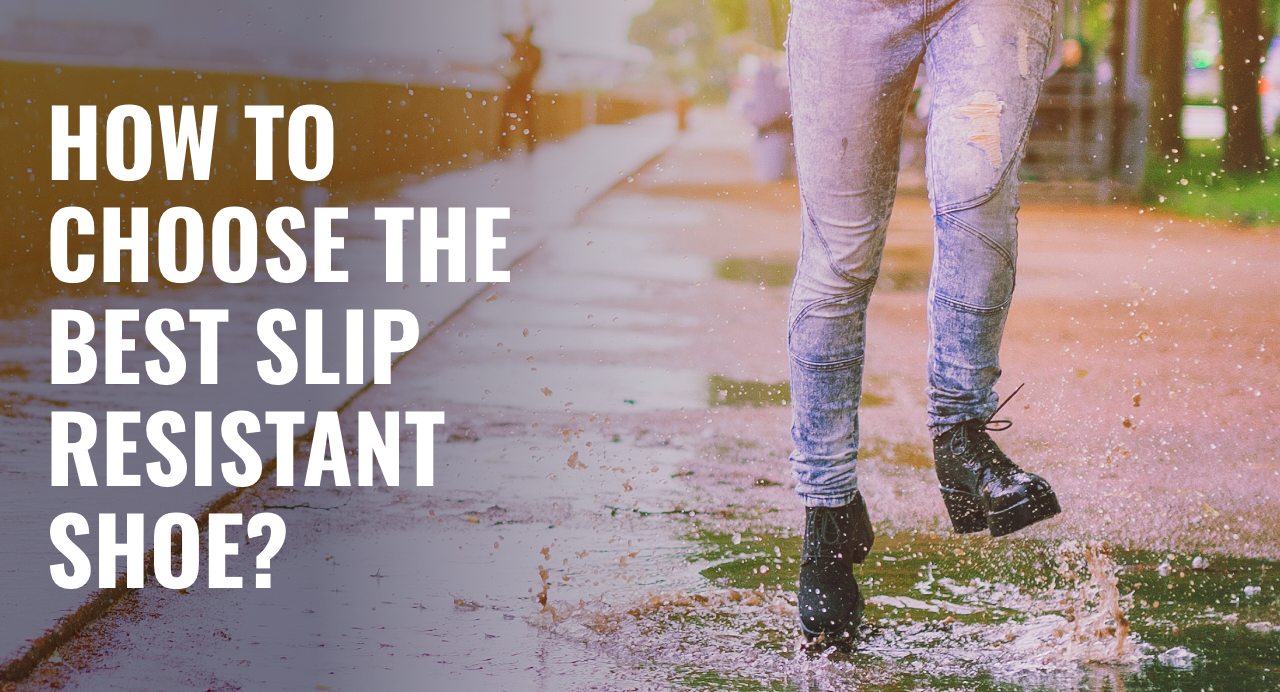How To Choose The Best Slip
Resistant Shoe?
One of the most needed but often overlooked requirements for many jobs is wearing slip-resistant shoes. Too many restaurant industry accidents, healthcare, or even construction and packaging accidents are preventable if only workers had the proper shoes.
For many, the problem is simply picking the perfect pair of slip-resistant footwear, as there are many factors to consider when choosing the right non-slip shoes, from grip performance to groove depth, durability, and even comfort. Another issue is that the market for slip-resistant shoes isn’t well-regulated, so many brands advertise their “non-slip” or slip-resistant products, although they’re not.
There isn’t a perfect slip-resistant shoe, but there are several that can be your favorites for any job. Let's first talk about why slip-resistant shoes are so important, and then we’ll share some of our favorites.
Schedule your
free foot analysis
What Makes Slip Resistant Shoes
Different?
Unlike everyday, regular shoes, slip-resistant shoes should do one thing well above all else: not slip. They achieve this by using soft rubber soles that incorporate grooves or tread that help the shoe grip onto most surfaces even when stepping on oil, food, water, ice, or other materials that might cause slips and falls.
But being non-slip is the bare minimum. There are overall three main factors that distinguish slip-resistant footwear from regular shoes.
Foot Protection and Injury Prevention
Imagine you’re a restaurant worker running back and forth from the kitchen to the tables, carrying knives, forks, boxes, heavy trays, hot liquids and plates, and other dangers that can easily injure your feet or toes. That’s why the first thing to look for in slip-resistant shoes for work is how well they protect your feet and prevent injury. Slip-resistant shoes must also be sturdy, thick, durable, and protect against a broken toe or a third-degree burn. Many slip-resistant shoes promote style over safety, to the detriment of a restaurant, hospital, or construction worker.
Anti-slip Outsoles
The outsoles are the key to making slip-resistant shoes effective. They are almost always made out of soft rubber, helping to alleviate the impact with every step.
Workers in the food service industry are 60 percent more likely to be injured at work than workers in other industries, according to a study by Emory University. Slip-resistant shoes are a requirement in most restaurants for this reason or are highly recommended. In fact, if your workplace doesn’t require them despite being in food services, hospitals, or construction, demand they make them mandatory or consider finding another job.
Arch Supports
A shoe supporting your arches is vital in any situation, especially for restaurants and healthcare workers who stand for or spend long hours on their feet. Food service workers and employees average 23,000 steps daily, or 10 miles while working. Add to that the thousands of pounds of stress our feet must bear with every step, and it’s clear a non-slip shoe must also deliver on arch support.
Excellent arch support is vital not just for providing safety and health but also for comfort during those long shifts at the hospital or restaurant. You also prevent sprains, twists, fallen arches, splints, and other foot ailments that come from poor arch support.
How To Choose the Right Slip
Resistant Shoe?
So, good arch support, traction on the soles, and protection are the three main aspects of a slip-resistant shoe. But how to choose the right one for you? Here, we walk you through the key considerations.
Tips for Finding The Best Anti-Slip
Shoes That Fit
Footwear selection has to consider several factors in addition to slip resistance, such as comfort, durability, and any other safety features required, such as toe protection. The final choice may have to be a compromise.
Value Comfort & Function Over Looks
Here’s a tip that might seem strange but works; purchase shoes after a full of day of working when your feet are swollen. That way, if you still feel comfortable when trying on a new pair of shoes, that means you’ll feel comfortable with them throughout the day. Moreover, make certain your toes have enough wiggle room in the toe box (the front of your shoes.)
And forget about personal style. We're not talking about casual shoes and heels. We’re talking about footwear for work, so comfort and not slipping on the job should be your priorities; if you find a fashionable pair of adequate slip-resistant shoes that are also comfortable, more power to you. But that shouldn’t be your priority. Also, ensure that the shoe is water-resistant and hard at the top. Your shoe must protect against burns and toe injuries, not just prevent a slip. Pick comfortable work shoes made out of black leather or polyurethane, which is both durable and easier to clean.
Always Get The Best Arch Support
It’s not enough for your shoes to prevent a slip. Some of the most common injuries for workers who walk and stand all day come from sore feet because of shoes that fail to deliver adequate arch support.
Without a good insole and midsole, our feet will pronate too much during those long hours of walking around in a hurry. When a foot pronates, our weight shifts towards the inside edge of it, and too much of that distorts the biomechanics and the distribution of pressure across the foot. This imbalance can lead to foot deformities like bunions, hammertoes, arch and heel pain, shin splints, tendonitis, and even knee and back pain.
A neat trick to check whether a shoe has good arch support or not is to try and bend them in half. If it doesn’t bend, that means it's sturdy enough to support your feet’s arches throughout the day.
Consider What Kind of Floor You Are Most Often Walking On
The floor you will be walking on the most with your new slip-resistant shoes is also important. Some non-slip shoes that work better against water might not be suitable for surfaces with a lot of oil (like an auto shop) or spilled food, which can block the cleats or grooves on the soles of the shoes.
Always ask first what each non-slip shoe is best for, and check how deep and spaced out the grooves are on the soles and the material. Most top-selling and well-rated slip-resistant shoes have this information available on the site or box.
Bring Your Own Shoe Inserts
If you usually wear shoe inserts, always take them with you when trying out new shoes, especially slip-resistant shoes for work. You need to be as comfortable as possible while being safe, including being with your inserts all day long. Look for a suitable footbed too, not just your insole, to support your arch. It must be made either of memory foam or an EVA (ethyl vinyl acetate) anti-compression insole.
Top 6 Best Slip Resistant Shoes For
Women
Don’t worry about spending hours sifting through our store catalog of slip-resistant shoes. We’ve taken on the task of compiling our top 6 non-slip shoes for women for you to pick from.
HOKA Women’s Bondi SR Wide Black
An extension of the popular Bondi line from HOKA, the Bondi SR gives you the cushion HOKA is known for and reworks the shape a bit to deal with the demands of daily life. It’s engineered with an EVA midsole for an entire day of plush cushioning that can save you from plantar fasciitis or bunions. It’s a workplace warrior updated to be water-resistant with leather and a slip-resistant outsole. With a proprietary compound for the outsole tested against industry standards, the Bondi SR has an ultra-grippy, full-ground contact rubber that can take anything the service and medical industry throws at it.
Softwalk Meredith Sport Black Box
The Meredith Sport is a revered clog among service industry workers known for being lightweight, flexible, slip-resistant, and supportive. On top of having an antimicrobial microfiber on its footbed, the Meredith comes with a removable arch support cushion that allows you to use your own orthotic.
BROOKS Women's Addiction Walker Suede Shark/Alloy
A great option for those wanting a bit more style on top of support, safety, and comfort. The Addiction Walker now has a suede upper, while the bottom is now SATRA TM144:2011-certified for slip-resistance. Added to this, you’ll get great support thanks to the Extended Progressive Diagonal Rollbar.
SpringStep Manila Black
Looking for a professional shoe and high-end comfort? Here’s the SpringStep Manila. These slip-on loafer-style shoes will let you have plenty of stretch and comfort due to the elastic gore on the sides and the soft lining inside. The triple-density antimicrobial footbed is removable so you can use your own orthotics. And, of course, the outsole is skid and oil resistant.
Aravon Hope Black
The slip-on design of the Aravon Hope Black will save you time easily, while on the inside, you’ll feel the padded heel support and cradle your foot. SATRA TM144:2011-certified for slip-resistance, these shoes will keep you safe and also supported thanks to the removable Ortholite® footbed. This shoe offers also superior sweat control thanks to the Dri-Lex® lining, keeping your feet on busy days cool and dry.
Dansko Women’s XP 2.0 Black Pull Up
It might look the same, but it now weighs less. Thanks to its new construction, the XP 2.0 Pull Up has an ergonomically designed and removable footbed with Dansko Natural Arch tech, offering exceptional support. And on top of that, it has a slip-resistant outsole.
FAQ
What type of shoes can prevent slips?
Look for shoes that clearly state they’re slip-resistant or non-slip. They must have rubber soles on the bottom that are grooved or textured and can grip most surfaces. As for price, don’t go for the cheapest ones. These should also protect against burns on your toes and heavy objects that might fall on them. Plus, they should be comfortable.
Are non-slip and slip-resistant the same?
Usually, yes. There’s no regulated definition of either, but those terms are used interchangeably in marketing and by experts like podiatrists. Some of the best slip-resistant shoes are SATRA TM144:2011-certified.
Do slip-resistant shoes work on all liquid spills?
No. Shoes that are good against liquid water or ice are not that good against oils and food spills, for example. Look for slip-resistant shoes that best fit your work environment. Some brands carry and offer more details about what materials the shoes have been tested against.
Does a rubber sole always make a shoe slip-resistant?
No. All slip-resistant shoes have rubber soles, but not all rubber soles are slip-resistant. The best outsoles for a slip-resistant shoe are made with soft rubber that can go against oil and grease and must be treaded. Tread is the grooves in the outsole that contribute to the grip and friction of a non-slip shoe. The deepness of the grooves or tracks affects the friction coefficient, and the deeper the tracks are, the more they siphon contaminant away from the sole.
How long do slip-resistant shoes work?
A well-worn slip-resistant shoe can last you for about six to 12 months, give or take. Maybe more if you don’t use them that often, but most people buy non-slip shoes precisely because they need them daily. It’s why a lot of businesses and employers offer shoe stipends or subsidies every year to ensure their workers are wearing slip-resistant work shoes or safety work shoes in the best possible conditions.
What are the requirements for a real slip-resistant shoe?
As mentioned before, due to a lack of standards and regulations about non-slip shoes and footwear, it can be difficult to choose the correct one. But overall, slip-resistant shoes should increase the friction between the sole of the shoe (the bottom) and the surface on which you’re on. They must provide a secure grip on floors and the ground so that you’re less likely to fall or lose your balance.
It also is important to choose nonslip shoes or safety shoes that meet specific demands of your job. If you’re working in a restaurant, prioritize restaurant shoes, chef shoes, or kitchen shoes that can withstand slick floors with water, grease, soap, and food remnants. If you work outdoors, get heavy-duty slip-resistant boots or shoes that can protect against gravel, mud, ice, or water.

Jerick Sobie
Since 2005, I have been a dedicated small business owner specializing in footwear retail. With over 20 years of experience, my business partner and I have helped customers find the perfect shoes that combine style, comfort, and quality. Our expertise extends beyond local sourcing—we have traveled internationally to discover high-quality footwear that meets our customers’ needs. In addition to running my business, I have participated in numerous health fairs and educational seminars, sharing my knowledge on proper footwear and foot health. Committed to providing exceptional service, We carefully curate our selections to ensure the best fit and support for every customer.






























































